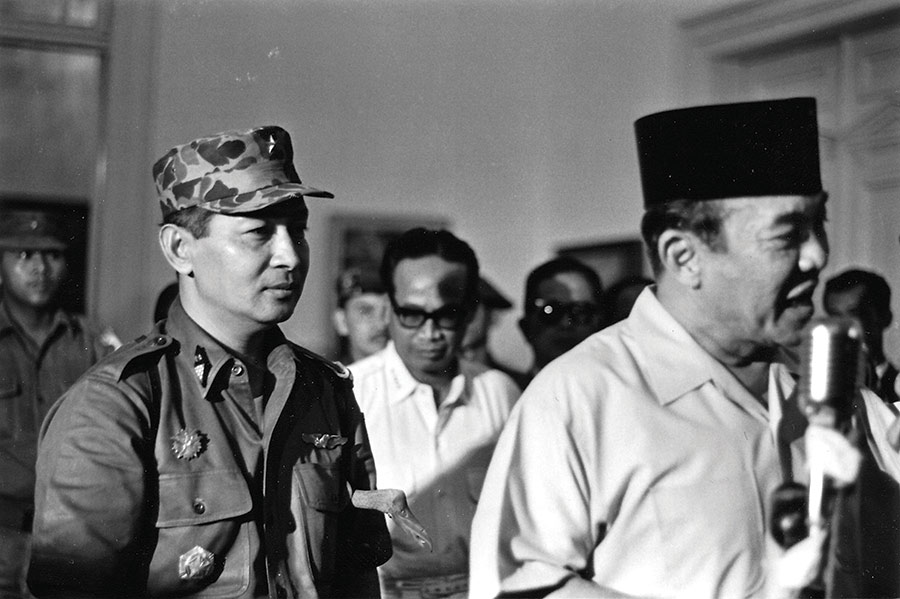Indonesia’s Killing Fields
The story of Indonesia’s anti-Communist coup, the rise to power of a pro-western regime and its murderous aftermath.
 ‘A quarrel in a faraway country between people of whom we know nothing.’ The notorious words of Neville Chamberlain come to mind when reading Geoffrey Robinson’s compelling new account of the violence that engulfed Indonesia more than 50 years ago. Despite the international success of recent documentary films, the massacres of 1965-66 remain stubbornly on the margins of global history.
‘A quarrel in a faraway country between people of whom we know nothing.’ The notorious words of Neville Chamberlain come to mind when reading Geoffrey Robinson’s compelling new account of the violence that engulfed Indonesia more than 50 years ago. Despite the international success of recent documentary films, the massacres of 1965-66 remain stubbornly on the margins of global history.
In The Killing Season Robinson shows conclusively that the governments of the United States and the United Kingdom encouraged, aided and abetted the Indonesian army’s murderous onslaught on the Indonesian Communist Party, the PKI – and engineered the fall of Indonesia’s first president, Sukarno, and the rise of a pro-western regime under General Suharto, which held dictatorial power until 1998.
Robinson makes telling use of newly released documents, which prove that the British and Americans settled on a joint policy of covertly helping the Indonesian Army crush the PKI. ‘The Indonesian business is developing in a way that looks encouraging’, reported US Under Secretary of State George Ball. ‘For the first time the army is disobeying Sukarno. If that continues and the PKI is cleaned up … we will have a new day in Indonesia.’
Robinson clears away the dense undergrowth of speculation that has blighted accounts of the massacres. Although he does not completely resolve the baffling ‘coup’ and the murder of army generals by the mysterious ‘G30S’ movement that provoked the campaign of mass killing, he makes it abundantly clear that it was Suharto and his army colleagues who exploited the crisis with lightning speed and, crucially, placed the blame on the collective shoulders of the PKI. Robinson dispenses with the hoary Orientalist myth that Indonesians are prone to ‘run amok’ and convicts the Indonesian army as the main agent of the massacres.
Most convincingly, Robinson shows that the pattern of violence was uneven across the archipelago but most intense where the army had support. On the island of Bali the onslaught was delayed for two months because the regional army commander, Brigadier General Sjafiuddin, was a supporter of Sukarno and close to Governor Suteja, who was a leftist. As soon as Suharto had neutralised the opposition on Bali, a violent killing spree erupted. Some 80,000 Balinese were murdered in three months. It was in these epicentres of violence, such as in Bali and Central Java, that army units inspired and organised local vigilantes and youth groups to carry out the killing – often using the most primitive means. The victims were killed with knives, sickles, swords, bamboo spears and iron rods and ended their lives miserably in isolated killing fields, such as plantations, beaches and riverbanks.
Robinson emphasises that a number of western officials were well informed about the mass killings and viewed what was happening as an important opportunity to crush the Communist menace in Indonesia. The British ambassador Andrew Gilchrist welcomed Suharto’s move against Sukarno, quoting a colleague who had praised the general for possessing ‘the courage of Patton and the intelligence of Montgomery’.One of the few diplomats to protest was the Swedish ambassador, Harald Edelstam, who travelled to some of the bloodiest of the Indonesian killing fields to personally find out what was happening. He was disgusted by what he saw.
Robinson scrupulously uses the term ‘massacres’ to characterise the tidal wave of violence that engulfed Indonesia which does not fit conveniently into definitions of genocide. The mass killings were not focused on the destruction of an ethnicity, race or religion, but on the extinction of alleged members of a political party. In his final chapter, Robinson raises the important question of whether the accepted definition of genocide needs to be refined and broadened. He argues that, even if the targets of mass violence are defined by their ethnicity or religion, the intention of the perpetrators always has a political dimension. Robinson’s masterly account of the terrible slaughters that took place in Indonesia offers important reflections on the nature of mass violence.
The Killing Season: A History of the Indonesian Massacres, 1965-66
Geoffrey B. Robinson
Princeton University Press 456pp £27




